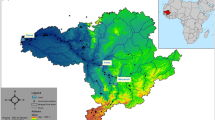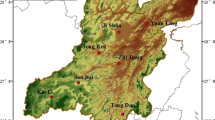Abstract
This study presents a basin-scale integrative hydrological, ecological, and economic (HEE) modeling system, aimed at evaluating the impact of resources management, especially agricultural water resources management, on the sustainability of regional water resources. The hydrological model in the modeling system was adapted from SWAT, the Soil and Water Assessment Tool, to simulate the water balance in terms of soil moisture, evapotranspiration, and streamflow. An ecological model was integrated into the hydrological model to compute the ecosystem production of biomass production and yield for different land use types. The economic model estimated the monetary values of crop production and water productivity over irrigated areas. The modeling system was primarily integrated and run on a Windows platform and was able to produce simulation results at daily time steps with a spatial resolution of hydrological response unit (HRU). The modeling system was then calibrated over the period from 1983 to 1991 for the upper and middle parts of the Yellow River basin, China. Calibration results showed that the efficiencies of the modeling system in simulating monthly streamflow over 5 hydrological stations were from 0.54 to 0.68 with an average of 0.64, indicating an acceptable calibration. Preliminary simulation results from 1986 to 1995 revealed that water use in the study region has largely reduced the streamflow in many parts of the area except for that in the riverhead. Spatial distribution of biomass production, and crop yield showed a strong impact of irrigation on agricultural production. Water productivity over irrigated cropland ranged from 1 to 1640 USD/(ha·mm−1), indicating a wide variation of the production conditions within the study region and a great potential in promoting water use efficiency in low water productivity areas. Generally, simulation results from this study indicated that the modeling system was capable of tracking the temporal and spatial variability of pertinent water balance variables, ecosystem dynamics, and regional economy, and provided a useful simulation tool in evaluating long-term water resources management strategies in a basin scale.
Similar content being viewed by others
References
Andrea W, Fohrer N, Moller D (2001). Long-term land use changes in a mesoscale watershed due to socio-economic factors-effects on land-scape structures and functions. Ecological Modeling, 140:125–140
Arnold J G, Srinivasan R, Muttiah R S (1994). Large scale hydrologic modeling and assessment. Proc. Annual Summer Symp. American Water Resources Association, 3–15
Arnold J G, Srinivasan R, Muttiah R S, Williams J R (1998). Large area hydrologic modeling and assessment. Part 1: Model development. Journal of American Water Resources Association, 34 (1):73–89
Berbel J, Gomez-Limon J (2000). The impacts of water-pricing policy in Spain: an analysis of three irrigated areas. Agric Water Manag, 43:219–238
Booker J E, Young R A (1994). Modeling intrastate and interstate markets for Colorado River water resources. Journal of Environment Economic and Management, 26(1):66–87
Braat L C, Lierop W F J (1987). Integrated economic-ecological modeling. Braat L C, Lierop W F J, eds. Integrated Economic Ecological Modeling, 49–67
Breuer L, Huisman J A, Steiner N, Weinmann B, Frede H G (2003). Eco-hydrologic and economic trade-off functions in watershed management. Proceedings of the second international SWAT conference Bari, Italy, 37–40
Cai X, McKinney D C, Lasdon L S (2001). Solving nonlinear water management models using a combined genetic algorithm and linear programming approach. Advances in Water Resources, 24 (6):667–676
Cai X, McKinney D C, Lasdon L S (2003). Integrated hydrologic-agronomic-economic model for river basin management. Journal of Water Resources Planning and Management, 129(1):4–17
Compaq Computer Corporation (2001). Compaq visual fortran programmer’s guide. Aug, Houston, Texas Houston, Texas
Cook S, Gichuki F, Turral H (2006). Agricultural Water Productivity: Issues, Concepts and Approaches, CGIAR CPWF Report. Basin Focal Project Working Paper No. 1
Dinar A, Letey J (1996). Modelling Economic Management and Policy Issues of Water in Irrigated Agriculture. Connecticut: Praeger Publishers
Dudley B J, Scott B W (1993). Integrating irrigation water demand, supply, and delivery management in a stochastic environment. Water Resources Research, 29(9):3093–3101
Fohrer N, Möller D, Steiner N (2002). An interdisciplinary modeling approach to evaluate the effects of land use change. Physics and Chemistry of the Earth, Parts A/B/C, 27 (9–10):655–662
Lefkoff L J, Gorelick S M (1990)a. Simulating physical processes and economic behavior in saline, irrigated agriculture: model development. Water Resources Research, 26(7): 1359–1369
Li X, Yang X, Luo Y, Dong S, Wang C, Deng X (2003). Farming productivity and resources sustainability in the Yellow River Basin, China. ASAE paper number: 033001. July, Las Vegas, Nevada, USA
Nash J E, Sutcliffe J V (1970). River flow forecasting through conceptual models-Part I: A discussion of principles. J Hydrol, 10:282–290
Noel J E, Howitt R E (1982). Conjunctive multibasin management: an optimal control approach. Water Resources Research, 18(4):753–763
Oweis T, Hachum A (2001). Reducing peak supplemental irrigation demand by extending sowing dates. Agric Water Manag, 50:109–123
Raju K S, Kumar D N (1999). Multicriteria decision making in irrigation planning. Agric Syst, 62 (2):117–129
Ringler C (2001). Optimal water allocation in the Mekong River basin, ZEF-discussion papers on development policy. Bonn: Center for Development Research, 38(5):50–58
Rosegrant M W, Cai X, Ringler C, Keller A, Donoso G, McKinney D C (1999). Report for the inter-American development bank on integrated economic-hydrologic water modeling at the basin scale: the Maipo River basin in Chile. Washington D C: IFPRI
Rosegrant M W, Ringler C, McKinney D C, Cai X, Keller A, Donoso G (2000). Integrated economic-hydrologic water modeling at the basin scale: the Maipo River basin. Agricultural Economics, 24:33–46
Vedula S, Kumar D N (1996). An integrated model for optimal reservoir operation for irrigation of multiple crops. Water Resources Research, 32(4):1101–1108
Vedula S, Mujumdar P P (1992). Optimal reservoir operation for irrigation of multiple crops. Water Resources Research, 28(1):1–9
Yellow River Conservancy Commission (2001). Background Material for Yellow River Basin
Zhang G P, Savenije H H G (2005). Interactive comment on “Rainfall-runoff modeling in a catchment with a complex groundwater flow system: application of the Representative Elementary Watershed (REW) approach”. Hydrology and Earth System Science Discussions, (2):345–359
Author information
Authors and Affiliations
Corresponding author
Rights and permissions
About this article
Cite this article
Li, X., Yang, X., Gao, Q. et al. Integrative assessment of hydrological, ecological, and economic systems for water resources management at river basin scale. Front. Earth Sci. China 3, 198–207 (2009). https://doi.org/10.1007/s11707-009-0029-1
Received:
Accepted:
Published:
Issue Date:
DOI: https://doi.org/10.1007/s11707-009-0029-1




